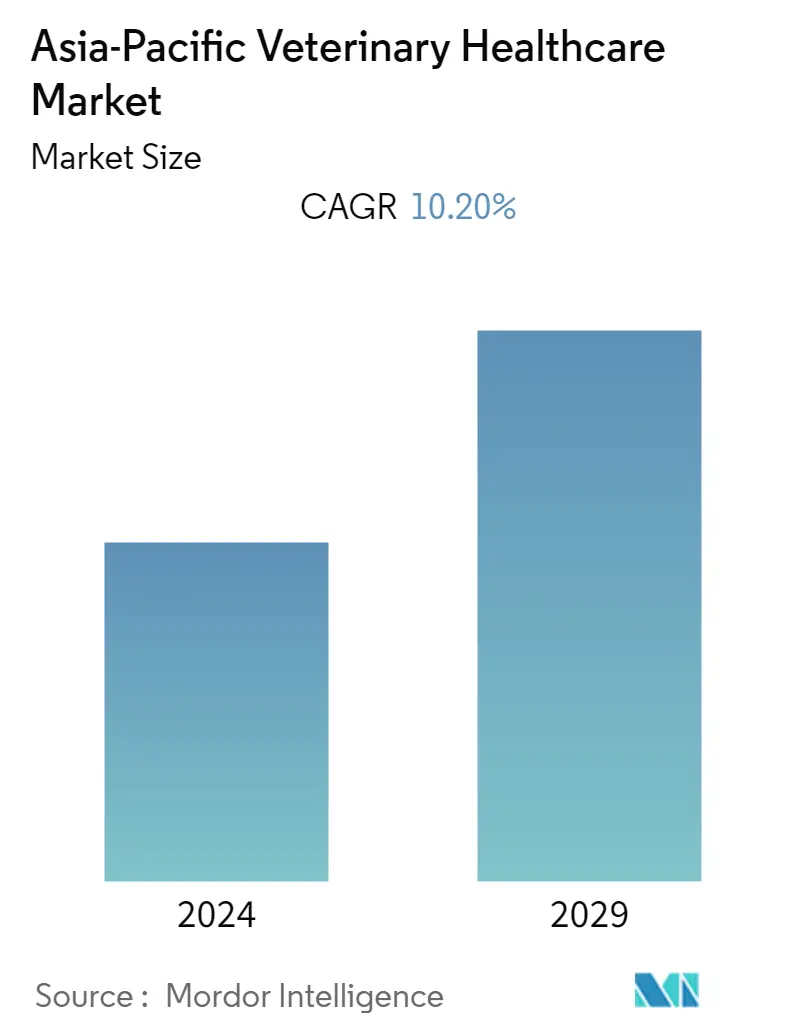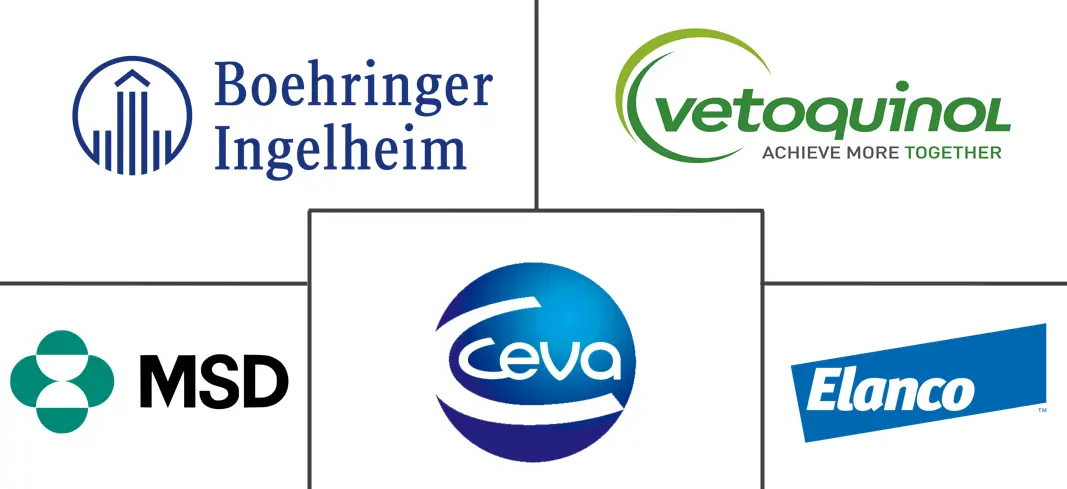Market Size of Asia-Pacific Veterinary Healthcare Industry

| Study Period | 2019 - 2029 |
| Base Year For Estimation | 2023 |
| Forecast Data Period | 2024 - 2029 |
| CAGR | 10.20 % |
| Fastest Growing Market | Asia-Pacific |
| Largest Market | North America |
Major Players
*Disclaimer: Major Players sorted in no particular order |
Asia-Pacific Veterinary Healthcare Market Analysis
The Asia-Pacific Veterinary Healthcare Market is projected to register a CAGR of nearly 10.2% during the forecast period (2022-2027).
The studied market witnessed a short-term impact owing to the decreased visits to veterinary hospitals and clinics during the initial phase of the Covid-19 outbreak. However, owing to the increasing adoption of pets during the pandemic in the countries across the Asia-Pacific region the focus on veterinary healthcare services increased. The government and non-government organizations for animals have taken steps forward to start new initiatives. Additionally, at the later phase of the pandemic, many service providers and organizations focused on veterinary healthcare to protect animals from Covid-19 infection in the region. For instance, in December 2021, with an investment of up to USD 10 million the Asian Development Bank (ADB) signed an agreement to take a stake in Zenex Animal Health India Private Limited (Zenex) to increase Zenex's production and distribution of quality animal health care products and help boost farmer incomes by mitigating livestock disease risk. ADB and Zenex will also work together on containing antimicrobial resistance across India, Bangladesh, Nepal, and Sri Lanka. Therefore, based on the factors stated above the Covid-19 pandemic is anticipated to have a significant impact on the market studied.
The Asia Pacific veterinary healthcare market is projected to have significant growth owing to the factors such as advanced technology leading to innovations in animal healthcare and increasing productivity at the risk of an emerging zoonosis. Currently, diagnostic lab equipment is easy to acquire, and the advancements in diagnostic equipment aid in providing better results efficiently. Furthermore, they can seamlessly provide electronic data charts for animals. Other factors responsible for the growth of the market studied include an increase in the number of the pet as well as farm animals and growing technological advancements in animal healthcare.
In the article 'Spike in Ownership Boosts Pet Care Retail Biz' published in September 2021 stated that pet ownership increased in India recently with an estimated pet population of 28-29 million, and dogs make up the highest pet ownership. On the other hand, the source also mentioned that cats have experienced a more recent increase in adoption and ownership, largely because of their perception that cats are more independent than dogs and need less maintenance. This increasing adoption of pets is anticipated to create opportunities for veterinary healthcare services and products in the country. Thus, the studied market is expected to boom in the region over the forecast period.
Moreover, the continuous involvement of market players in collaboration, partnerships, and development of innovative products is increasing in the region recently. For instance, in August 2021, QBiotics Group Limited (QBiotics), an Australian life sciences company developing novel small molecule anticancer and wound healing pharmaceuticals, received approval from the Australian Pesticides and Veterinary Medicines Authority (APVMA) for the veterinary product STELFONTA (tigilanol tiglate). This approval represents Australia's first pharmaceutical treatment available for all grades of canine non-metastatic MCT. Furthermore, precision management systems have been used explicitly to improve animal welfare. For instance, real-time automatic video monitoring of chicken houses can be used to detect zones of low or abnormal occupation and malfunctioning feed. It can trigger an automatic alarm to alert the owner. These are several developments that are conducted in the Asia-pacific region, which are further expected to bolster the market growth.
Thus, owing to the factors mentioned above, the Asia-Pacific veterinary healthcare market is expected to exhibit good growth over the forecast period. However, the increasing cost of veterinary services coupled with the lack of infrastructure and funding and the use of counterfeit medicines might hamper the market growth over the analysis period.
Asia-Pacific Veterinary Healthcare Industry Segmentation
As per the scope of this report, the Asia-Pacific veterinary healthcare market comprises of therapeutic and diagnostic products and solutions for companion and farm animals. The Asia-Pacific Veterinary Healthcare market is segmented by Product (Therapeutics and Diagnostics), Animal Type, (Dogs, Cats, Horses and Other Animals), and Geography (China, Japan, India, Australia, South Korea, and Rest of Asia-Pacific). The report offers the value (in USD million) for the above segments.
| By Product | |||||||
| |||||||
|
| By Animal Type | |
| Dogs | |
| Cats | |
| Horses | |
| Other Animals |
| Geography | |
| China | |
| Japan | |
| India | |
| Australia | |
| South Korea | |
| Rest of Asia-Pacific |
Asia-Pacific Veterinary Healthcare Market Size Summary
The Asia-Pacific veterinary healthcare market is poised for substantial growth, driven by a combination of factors including increased pet ownership, technological advancements, and strategic collaborations among key market players. The market experienced a temporary setback during the initial phases of the Covid-19 pandemic due to reduced veterinary visits. However, the surge in pet adoption during the pandemic and subsequent initiatives by government and non-government organizations have bolstered the demand for veterinary healthcare services. Investments, such as those by the Asian Development Bank in Zenex Animal Health, highlight the region's commitment to enhancing animal health care product distribution and addressing antimicrobial resistance. The market's expansion is further supported by innovations in diagnostic equipment and precision management systems, which improve animal welfare and healthcare outcomes.
The segmental growth within the Asia-Pacific veterinary healthcare market is attributed to continuous innovations in vaccines and increased awareness about animal health. The presence of key market players offering a diverse range of veterinary vaccines is expected to drive this growth. Government initiatives, such as vaccination drives and programs to combat livestock diseases, also contribute to the market's positive outlook. Despite challenges like high veterinary service costs and infrastructure limitations, the market remains competitive, with players focusing on strategic partnerships and product launches to enhance their market presence. The ongoing developments and investments in the region are anticipated to significantly impact the market's trajectory over the forecast period.
Asia-Pacific Veterinary Healthcare Market Size - Table of Contents
-
1. MARKET DYNAMICS
-
1.1 Market Overview
-
1.1.1 Advanced Technology is Leading to Innovations in Animal Healthcare
-
1.1.2 Growing Adoption of Animals Coupled with the Risk of Emerging Zoonosis
-
-
1.2 Market Restraints
-
1.2.1 Increasing Cost of Veterinary Services Couple with the Lack of Infrastructure and Funding
-
1.2.2 Use of Counterfeit Medicines
-
-
1.3 Porter's Five Forces Analysis
-
1.3.1 Threat of New Entrants
-
1.3.2 Bargaining Power of Buyers/Consumers
-
1.3.3 Bargaining Power of Suppliers
-
1.3.4 Threat of Substitute Products
-
1.3.5 Intensity of Competitive Rivalry
-
-
-
2. MARKET SEGMENTATION (Market Size by Value - USD million)
-
2.1 By Product
-
2.1.1 By Therapeutics
-
2.1.1.1 Vaccines
-
2.1.1.2 Parasiticides
-
2.1.1.3 Anti-infectives
-
2.1.1.4 Medical Feed Additives
-
2.1.1.5 Other Therapeutics
-
-
2.1.2 By Diagnostics
-
2.1.2.1 Immunodiagnostic Tests
-
2.1.2.2 Molecular Diagnostics
-
2.1.2.3 Diagnostic Imaging
-
2.1.2.4 Clinical Chemistry
-
2.1.2.5 Other Diagnostics
-
-
-
2.2 By Animal Type
-
2.2.1 Dogs
-
2.2.2 Cats
-
2.2.3 Horses
-
2.2.4 Other Animals
-
-
2.3 Geography
-
2.3.1 China
-
2.3.2 Japan
-
2.3.3 India
-
2.3.4 Australia
-
2.3.5 South Korea
-
2.3.6 Rest of Asia-Pacific
-
-
Asia-Pacific Veterinary Healthcare Market Size FAQs
What is the current Asia-Pacific Veterinary Healthcare Market size?
The Asia-Pacific Veterinary Healthcare Market is projected to register a CAGR of 10.20% during the forecast period (2024-2029)
Who are the key players in Asia-Pacific Veterinary Healthcare Market?
Vetoquinol, Elanco, Boehringer Ingelheim International GmbH, Merck & Co., Inc. and Ceva are the major companies operating in the Asia-Pacific Veterinary Healthcare Market.

